Even if you can get used to the awkward controls, Star Fox Zero is merely mediocre. It’s as disappointing a major Nintendo console release as there’s been in some time.
You’re Fox McCloud himself, once again the pilot of your very own Arwing fighter, flying (or on rare occasions driving) a tank through missions in a sci-fi adventure. You swoop through battlefields and past obstacles, tracking and shooting down swarms of enemy tanks, planes, missiles, mechanised spiders, giant space birds and the like along the way.
The game’s core concept is that a futuristic fighter pilot doesn’t just have hands and eyes but also a neck that turns their head. A real, futuristic fighter pilot might use their hands to move a flight stick, which tilts and turns their jet. They might turn their neck to look around in their cockpit and notice the position of targets next to them or above them. The designers of Star Fox Zero have decided to let players do all of that, theoretically giving them more control than they have ever had in a Star Fox game.
Star Fox Zero‘s most obvious problem, though, is that its designers at Nintendo and Platinum Games executed that good, core idea poorly, thanks to some combination of hardware limitations and odd design choices. It’s not easy to explain what is wrong with the game’s design, but, given that I humbly think I’ve solved Star Fox Zero‘s controls, please bear with me.
First, observe the game’s odd approach to two-screen display. As you play the game, the TV shows a traditional external view of your Star Fox Arwing. The GamePad screen displays your pilot’s view from the cockpit.
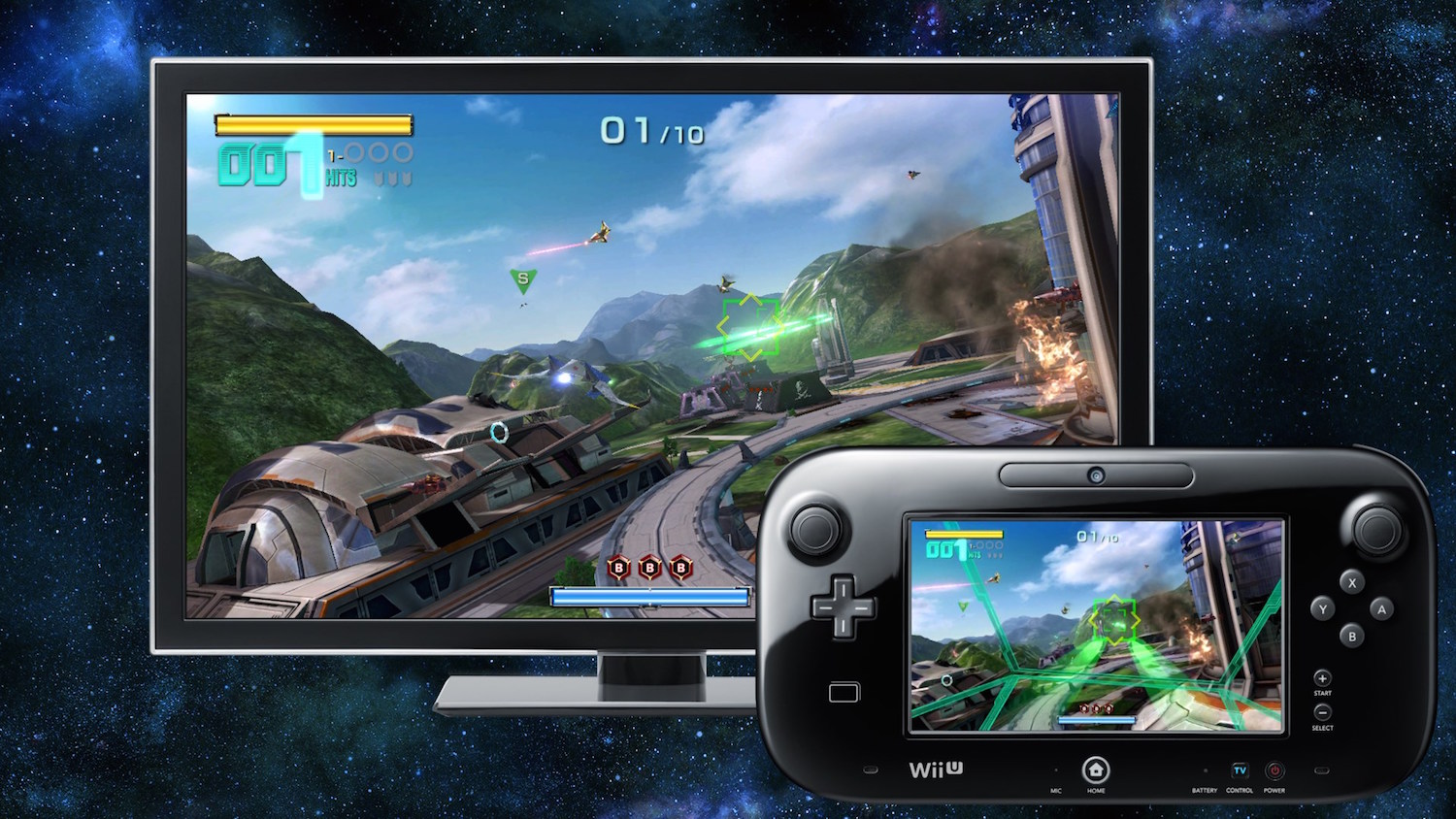
The hands of your in-game pilot, Fox McCloud, are mapped, uncontroversially, to the left analogue stick of the Wii U’s GamePad. This allows you to manoeuvre Fox’s craft up and down, left and right, as he blasts through battlefields. It will also move his targeting reticule a bit, helping you draw a bead on some incoming enemies.
The input for moving Fox’s neck (and head) is what makes this scheme awkward and frequently unpleasant. His neck is controlled with tilts of the Wii U GamePad. In theory, Fox is sitting in a glass bubble of a cockpit with an unobstructed view of what is above and below him. Tilt forward with the GamePad, and he will bow his head to see the battlefield below him. That bottom-looking view will appear in the GamePad, even as the TV will still display what is in front of Fox’s Arwing. Tilt up, and the GamePad will see what is above Fox. Tilt left or right, and he is craning his neck to see an enemy who has flown past him. This is how it works in the game’s tank sequences, too.
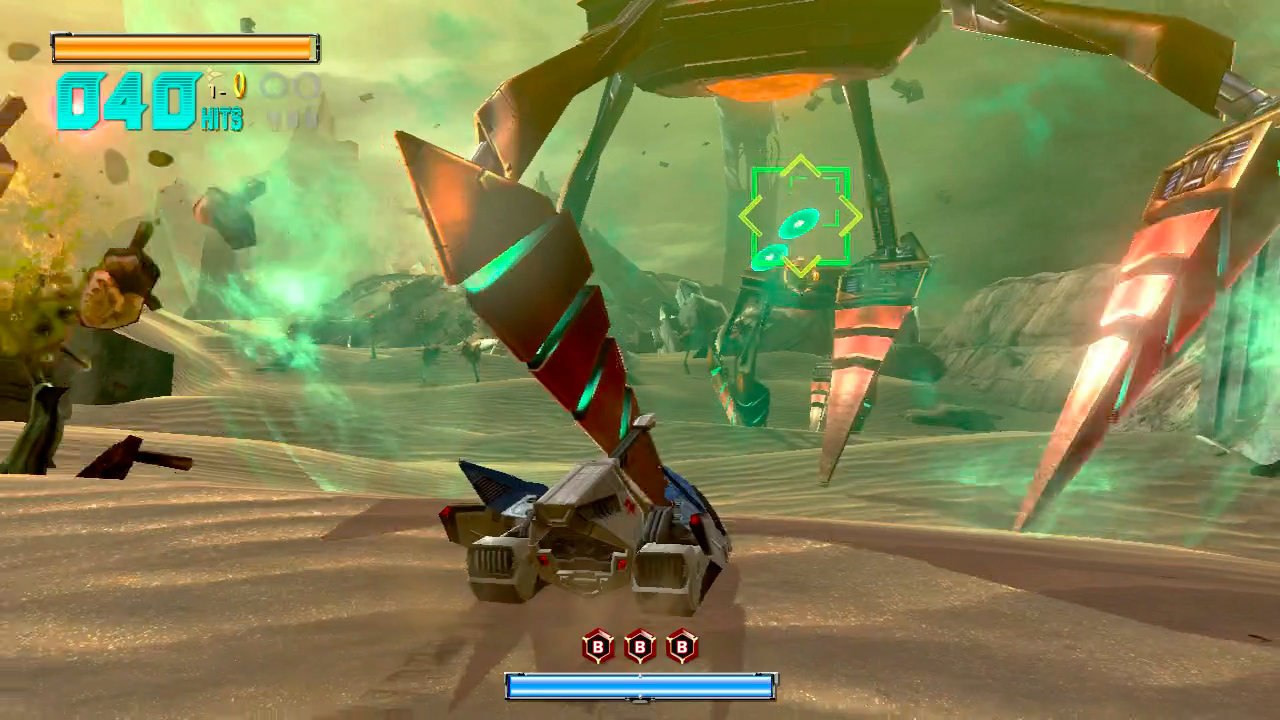
This is the kind of enemy designed to encourage you to use the GamePad to tilt Fox’s head back for better targeting.
As you play the game, enemies will enter your field of vision. You can try to shoot them down while looking at either screen. The targeting reticule appears on both displays, and your lasers will fire wherever it points. Enemies are seldom simply in front of you. To make the most of the neck option the game will frequently put targets above or below you. Picture flying toward a tank on the ground that has a weak spot on the roof. You’re expected to fly over it, tilt Fox’s head down and shoot the roof. The game sometimes produces big spider walkers that you have to fly under, requiring you to rock Fox’s head back to shoot at the weak spots on their undercarriage.
In theory, this is all fine, but the controls too frequently leave your aim askew or leave Fox’s vehicle vulnerable to being blindsided. Any motion-control scheme requires not just that the controller responds to the twists and turns of a player’s hands, but that it’s easy to set things back to a resting, zero position. Without that easy ability to return to zero, you’d be playing motion-controlled Mario Kart and never be able to get Mario to stop turning and drive straight. In Star Fox Zero, not getting back to a zero resting position will keep you from being able to shoot straight, which turns out to be an all too common problem.
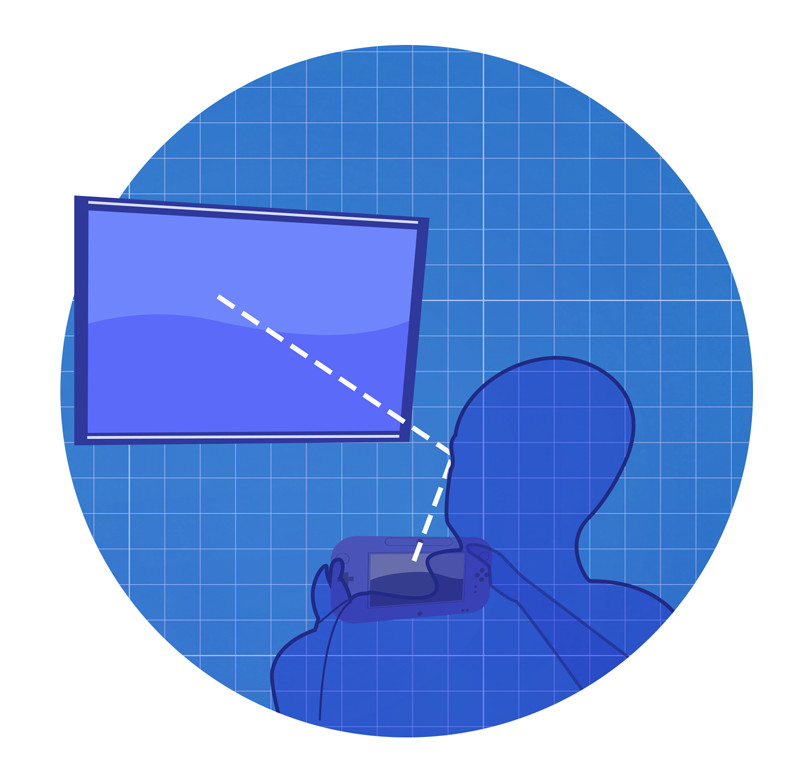
Do not play Star Fox Zero this way. Holding the controller in the air is a recipe for badly calibrated motion control confusion, as is splitting the two displays too far apart. (Schematic by Sam Woolley.)
As I played the game, especially in the first few days that I had it, I found that the GamePad’s resting point seemed to wander as I tilted it. You can press in on the left analogue stick to instantly recalibrate and recentre it, but then the zero point of the motion controls will be tied to a physically tilted GamePad position. Instead, I usually tried to use my hands to level the controller back to a default, zero position. I usually had to do that just by feel, since I was looking at the TV half the time. It’s not as easy as it sounds, because of how the controller’s sensor wanders and because the TV view doesn’t give much indication, if any, about the position of Fox’s head. If you look down at the GamePad screen to check his view and to be sure you’ve straightened out, you now have the problem that you’re not seeing whatever might be on the verge of colliding with your Arwing from the side. That’s something you could see if you were looking at the TV.
I wrestled with Star Fox Zero‘s controls for days, because I liked the idea of omnidirectional aim and peripheral awareness that are behind them. I was sure that I could develop the dexterity to make them work. I kept failing. A few days into struggling with the game, I tried switching views. I put the cockpit view on my TV and the external ship view on my GamePad. It was no better.
And then, I figured it out. I figured out a better way to sit and a better way to hold the controller while playing this game. Folks, I don’t like to brag, but I think I solved Star Fox Zero’s controls. The secret was to use my leg.
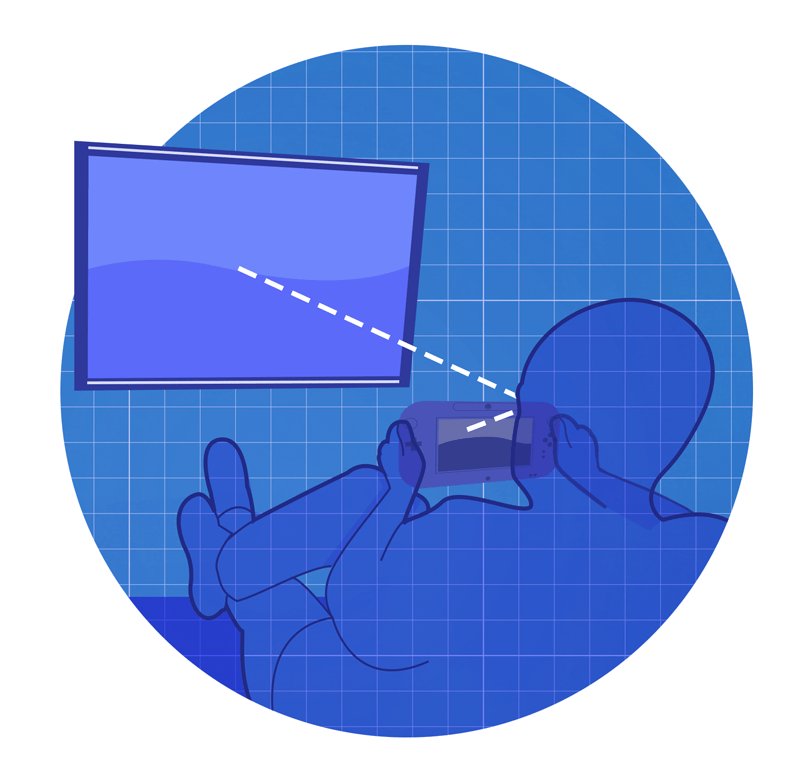
Play Star Fox Zero this way. Recline. Brace the controller or a hand that is holding the controller partially against your leg so that you don’t accidentally tilt it and can easily re-center it by feel. Prop it up high enough so you can see both displays at once. (Schematic by Sam Woolley)
Consider this the missing page to Star Fox Zero‘s instruction manual.
If you are playing the game, sit down, stretch your legs and lift them onto an ottoman or chaise lounge or even the back of a large and motionless dog. Pull one foot in, making a peak with your knee. Hold the GamePad in your hands, and brace the side of one of your hands against your knee or upper thigh. Make sure the GamePad screen appears to be just below the TV screen beyond it.
If there is a way to play Star Fox Zero with power, this is it. Because you are bracing the GamePad against your leg, you will mostly be able to keep it still and not mistakenly trigger its motion controls. If you do look down and tilt the controller to take out an enemy below you, you’ll be able to get back to a default position without even looking at the GamePad by using the feel of your hand or controller against your leg to orient things. You will also easily be able to swiftly glance from the TV screen to the GamePad, maintaining peripheral vision of one while looking at the other. You’ll never be flying blind.
In your reclined pose, you will be a success.
(Side note: The other way to conquer Star Fox Zero‘s controls is to try its co-op mode, leaving one person to worry about the TV view and flight controls while the other person worries about the cockpit tilt controls. Both players have their own targeting reticule for aiming and shooting and can compete to see who shoots down more enemies.)
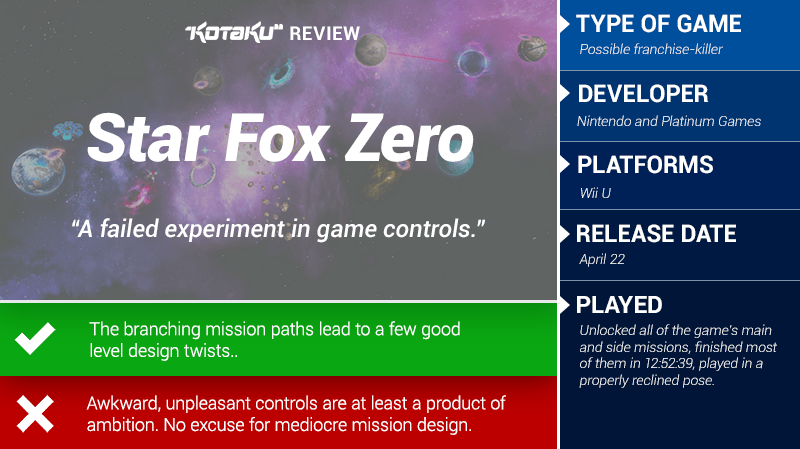
Once you correctly grasp the game’s controls, you can proceed to play a Star Fox game that unfortunately feels unfinished. There is no brilliant game hiding beyond the awkward controls. There is a mediocre one. Zero is saddled with dull level design that is passable but far below expectation, not just for Nintendo but for their partners at Platinum, who’ve long specialised in offering games of uncommon, memorable spectacle.
Star Fox Zero plays as a loose remake of 1997’s Star Fox 64. The Nintendo 64 game, like the original Star Fox on Super Nintendo, put you in on-rails missions that moved forward on their own. It also threw Fox and the rest of his squadron into arena-shaped free-flight missions that focused on dogfighting. The Wii U game does the same thing, mixing auto-scrolling and free-flight levels. The N64 game mostly put you in an Arwing fighter jet but also let you drive a tank and a submarine. The Wii U entry is mostly Arwing, but also offers missions involving a tank or a hovercraft. Zero borrows some level designs from the 1997 game, though sadly, the UFO and train battles don’t return. Zero‘s designers had their own ideas, but they mostly amount to unmemorable battles over generic battlescapes.
Throughout the game Fox’s wingmen Falco, Peppy and Slippy repeat familiar lines from the N64 game. Veteran players will feel like they have done all this before and had more fun doing it back then.
It’s tough to convey mediocre game design in footage. Any small glimpse of a game might look like a lot of fun. For your own judgment, here’s the start of Zero‘s first level, which at least has the foundation of the opening Corneria battle from Star Fox 64 on which to build. It’s a reimagining of that level. You won’t hear Fox or his co-pilot’s audio, because that emits from the GamePad’s speakers. You’ll notice that the game looks smooth but primitive because the Wii U is having to output two distinct video signals to the game’s two displays and run both at a high framerate:
New ideas in Star Fox Zero include the ability to transform the Arwing into a walker and a new hovercraft that drops a little, tethered robot that you control with the GamePad and use to collect coins or hack open locked passageways. The walker is lightweight and awkward to control. The hovercraft-robot combo is just boring.
None of it is special enough to feel worth the formidable barrier put up by the game’s controls.
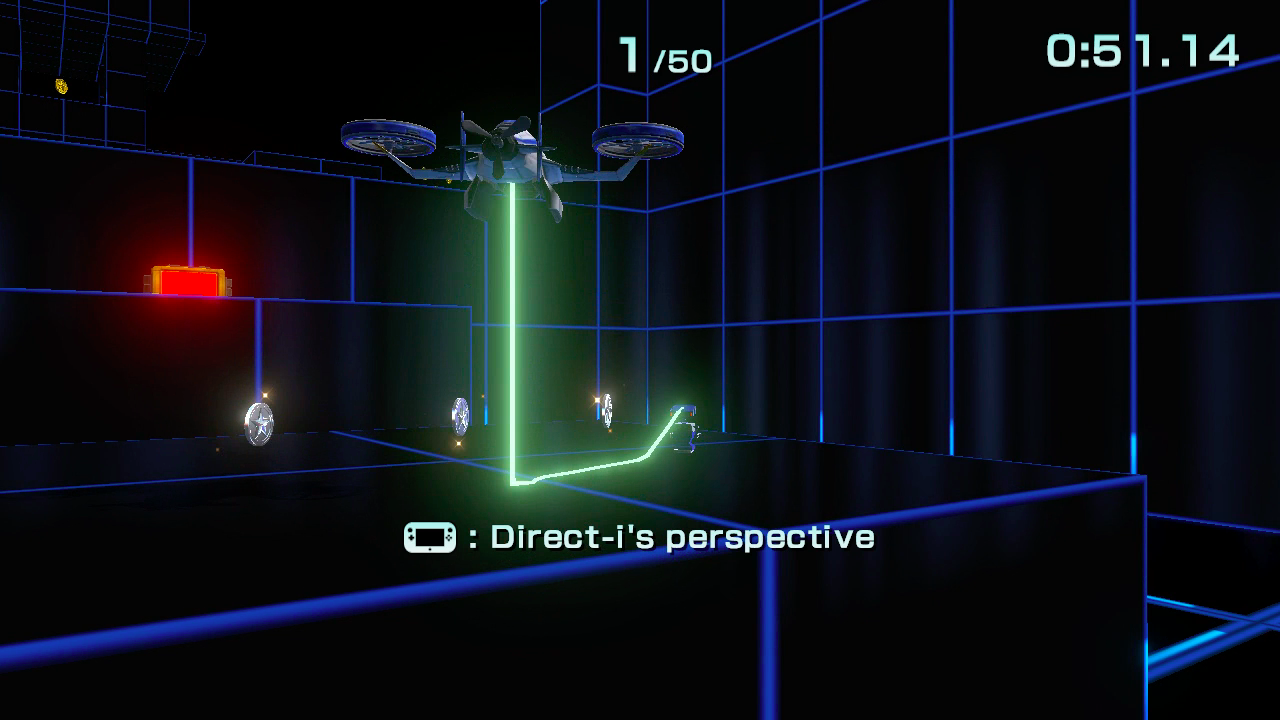
The new Gyrowing hovercraft drops a little hacker robot whose perspective is shown on the Wii U’s GamePad screen.
The sum of Star Fox‘s levels is at least greater than the parts, since the game brings back the branching level concept from Star Fox 64 and makes a minor puzzle out of figuring out how to find the alternate exists to some of its levels. The Nintendo 64 game, like this Wii U one, was designed for distinct, single-sitting playthroughs that lasted only an hour or two but varied based on how you navigated the branching sequence of levels. Some of the game’s missions had multiple end states, allowing skilled players to branch off toward more interesting levels or to take surprising shortcuts. Star Fox Zero‘s branches lead to more interesting skirmishes than what you’ll find on the default path, but there unfortunately just aren’t that many levels with alternate exits to justify the lacklustre mission-specific design. (A display in the game’s unlockable no-continues Arcade Mode shows how many branches there are, so click here if you want to see).
Spoiler about something structural that happens after you beat the game the first time…
After you initially beat Star Fox Zero‘s final boss in a single-sitting playthrough, the game frustratingly flirts with the concept of reconfiguring its levels. Some early levels become accessible with different Star Fox vehicles and flow very differently. A slow-paced level initially navigated carefully with a hovercraft, for example, becomes a rapidly-scrolling mission flown through with an Arwing. The remixes are good. Unfortunately, only a small number of the game’s early levels get these alternate designs, making this promising aspect of the game’s level design feel abandoned halfway through.
End spoiler.
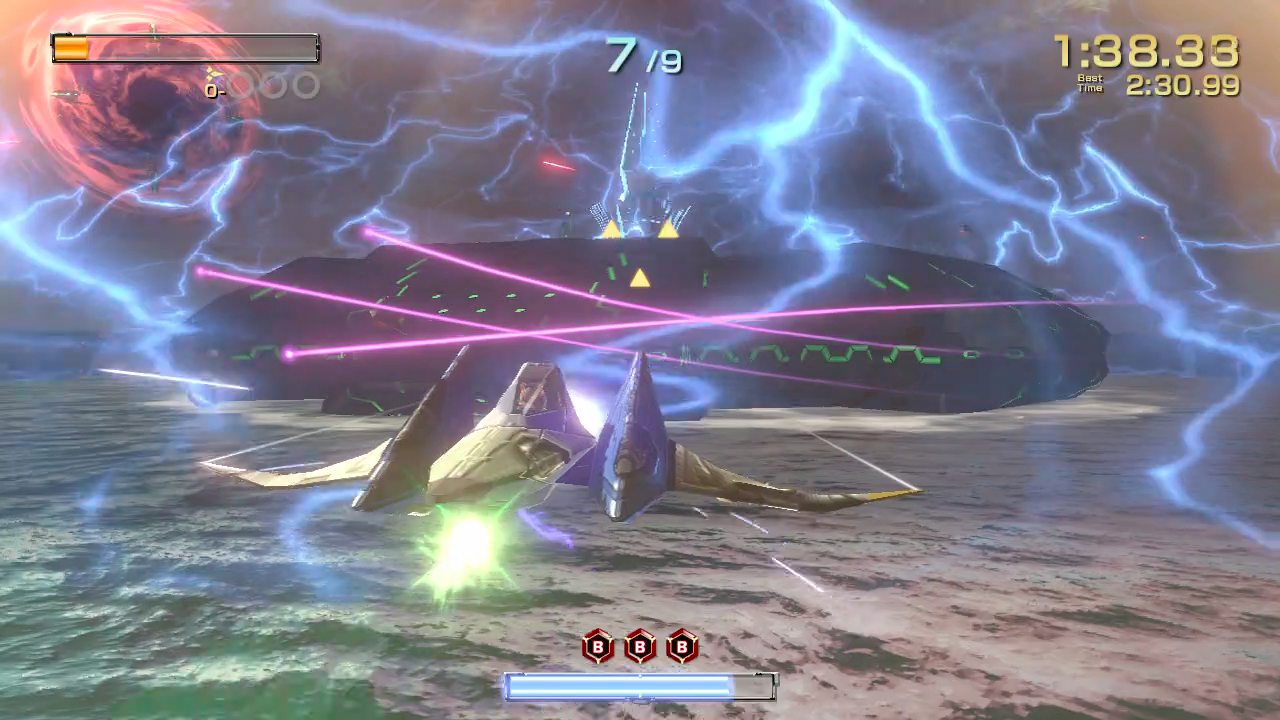
Ultimately, Star Fox Zero‘s biggest problem is that its weak level design and flawed controls smack of a game that was designed less through the spark of creative inspiration and more with the intent to justify the unpopular and unconventional two-screen Wii U console. The game was first presented to reporters at a small press showcase at E3 in June of 2014, where Nintendo’s brilliant game designer Shigeru Miyamoto showed off a trio of experiments for a console that was a year and a half old and flailing. Back then, the Wii U badly needed its equivalent of a Wii Sports or Nintendogs, games that explained the utility of other oddball Nintendo gaming machines in ingenious, popular ways.
The experiments Miyamoto presented at that showcase used game designs that required a console that had a separate screen in its controller. One was bad: the clumsy Project Giant Robot (which let you see through a big robot’s eyes while steering him through a city that was shown on the TV) joined the likes of Tetra’s Trackers and Donkey Kong Plus as a Nintendo game concept that never got past E3. One was good: the inspired surveillance-baced tower defence game Project Guard evolved into the terrific Star Fox Guard.
And then there was Miyamoto’s Star Fox concept, which back then was just that hands-neck control scheme. It would take some time to get used to, reporters were told then. The demo had potential, sure, but it seemed a little off.
Nearly two years later and after a sizable delay from its planned November 2015 release date, the results are, at best, OK. The split view feels like a half step toward a design that would have worked better, perhaps, if played through a virtual reality headset that could map the fighter pilot’s neck to a player’s actual neck.
Even after I found a way to wield its unwieldy controls, the game underneath those controls is a lukewarm retread. As a flagship Nintendo console release or even as a worthy sequel to a once-great franchise, Star Fox Zero just doesn’t cut it.
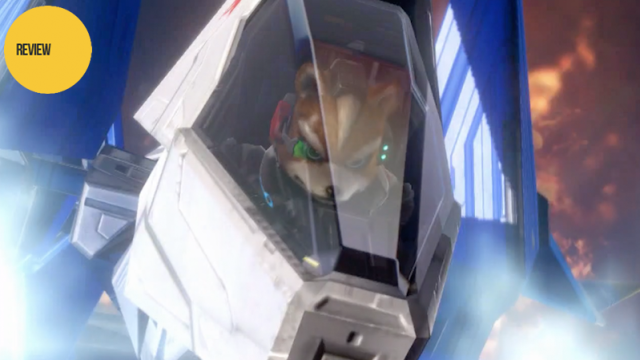
Comments
26 responses to “Star Fox Zero: The Kotaku Review”
That is a shame. I don’t know, IGN’s and Easy Allies’ video reviews seemed like the game is worth it, but Kotaku and Giant Bomb disagree. I might get it later for cheaper then…
Vooks gave it a good review too. 5/5.
Nintendo could sell a fart in a box and some people wouldn’t fault it.
Even if you think the controls are genius, it’s still short, derivative, bland looking (by 2016 standards) and has framerate issues. Those are fairly tangible flaws, they aren’t really the kinds of things that can be completely ignored even if you think the level design is brilliant and the controls are fun.
Starfox 64 is still a game I love to bust out when I get a chance, and I’d love to play a modern adaptation/ remake, but I can’t imagine any circumstances under which I could find an updated Starfox to be a 5/5 title at full retail price in 2016 unless it nailed every aspect of the Starfox formula and elaborated on it with plenty of creativity.
I bought it just moments ago. I waiting for the kids to get off Minecraft before I can give it a go.
I’m not worried about the controls… (Remember when the reviewers said Wonderful 101 and Splatoon had ‘bad controls’). However, I do believe level design may be compromised since the game was essentially rushed.
That said, we’ll make good use of co-op in our family and there’s enough 8/10 reviews for me to give it a shot.
An optimist – I like it. I hope it works out for you!
Yep, loving it so far. Single Player was ok. It was a bit fiddly, but I did appreciate that I was doing something new. I only played the first level, but I’m keen for more.
However, co-op with my 8 year old was tons of fun. I was driver and he was gunner and it was great co-ordinating our way through about 4 or so levels.
I feel like every Nintendo IP, outside of Pokémon and Metroid Prime, needs its Super Mario Galaxy moment. A complete rethink not only in terms of presentation, but in storytelling. I’m a Starfox fan, so I’ll enjoy this bad controls or no, but I’ve always felt it’s the one IP in Nintendo’s back catalogue that deserves something … bigger. Grander.
Hopefully the response here will have the big N rethinking its stance, in a similar way they’re looking at Zelda’s next adventure.
I think it would look super if they used cel shading like the Zelda Wii U (check the trailer, it’s beautiful) and used traditional controls and the gamepad….well whaterver. You’d be able to output a beautiful looking game. Also, better levels. That would be my ideal Star Fox game.
Sounds like they came up with the control scheme (making use of the 2nd screen) first, and were bound by it the whole way through.
Co-Op sounds like a blast, but other than that it seems like it would be better with a standard control layout, and full graphics on the main (only) screen.
Did I miss a co-op review in this or no? I remember the main focus of this game being the co-op rather then playing on your own.
If the focus is on co-op then it’s only because the controls are so retarded that one person can’t play it.
It’s a sequel/ reboot of a series that’s always been focused on single player, that’s been marketed on the basis of single player, to an audience that expects a single player title. My understanding is that it was balanced for and the levels designed for a single player.
If it needs two people, it’s because they f*cked up.
If they had simplified controls such as starfox64/lylas wars do you think the game would have been better? Or are the ‘different’ controls the main selling point and a major part of the games mechanics?
I’m really liking the level design so far. It’s classic Star Fox but they’ve also thrown a little Blast Corps in the mix with the vehicles. Unfortunately this makes the controls harder to get used to. Personally I’m struggling with the controls. I hate to harp on it because aside from the controls it’s a really good game, but this isn’t like Star Fox on the DS where the controls weren’t perfect but I got used to them. My brain just isn’t wired for this. The idea of tilting the controller for ‘precision aim’ while holding a game pad is crazy to me.
I’m finding that if I just focus on the cockpit view I do better but it’s a really bad way to play a game like Star Fox. I’d kill for a Pro controller right now.
I’ve spent a bit of time with it this weekend and it’s still super annoying. I’m pretty much ignoring the second screen and using it like the PS3’s SIXAXIS. It’s made it a little better but there’s quite a lot that relies on you using the gamepad screen.
I feel like I have a special targeting computer that I can bring up for extra precision. Frankly, it’s not that different than the “Iron sights” option in most FPS games.
More stupid gimmick controls
more repetitive games on ps4 😛
The d-pad was once a “gimmick”. So was the analogue stick. And the trigger controls. And the wii-mote. Without so-called gimmicks gaming would never have moved forward.
Nintendo don’t move forward. They have amazing games but their obsession with using unconventional control schemes just divides and alienates gamers. The wii was a novelty. And incredibly irritating to force gamers to use motion controls.
“Nintendo don’t move forward” …? Are you serious? They do nothing BUT move forward. I…i don’t even know what to say. Surely you are being witty or sarcastic or something.
My wife picked up my first print edition copy yesterday but unfortunately I’ve been in hospital so I’ve been unable to play it :/
I’m not too concerned about the controls, I’m sure I’ll pick it up – and as for the level design I don’t care either as long as it’s along the lines of Lylat Wars.
I’m kinda more excited to get my hands on the project guard game… I’ve been looking forward to this for ages.
Good review but i do take issue with it saying that the game was rushed – it was meant to be released last year but was pushed back til late April so that doesn’t really say to me it was rushed. Perhaps the levels are meant to be simplistic in nature?
Also i lol’d at the motionless dog comment, thinking about my 40kg mutt on my lap and her constantly doing flips and pushing her elbows into my groin. I WISH i had a motionless dog, hahaha.
I hope you get out of hospital to enjoy it soon.
Thank you 🙂
I actually kind of liked the combo controls for star fox – it was fun a reminiscent of when you’re a kid and jerk the controller to the side in the hopes it will help you avoid an obstacle. Although I haven’t done every alternate path level yet, I had two big (not nostalgia related) problems with star fox zero:
1. The boss battles that take camera control away from you. I get that they want you to use to cockpit view for some bizarre reason (as evidenced by James’ “trust the view from your cockpit” in the andross battle) but why? – none of those fights really required reliance on cockpit controls, and it made what could have been fun fights tedious – this was especially frustrating when you were expected to rely on the large screen to know which way to dodge – with the controls inverted of course because you’re looking at it backwards
2. The absence of an on screen map. Seriously. The above could be forgivable if you had a map to pin point where you are. In the final battle with Star Wolf (which was fun) I actually lost the last member and spent a while flying around and waiting for them to attack me again – since there was no map I had no idea what direction to go in.
Nintendo regurgitating a 20 year old title on outdated hardware with a bad controller gimmick?
Nooooooo…..
To be fair I don’t know what more they could have done really- the on-rails shooter is a bit of a relic, even if it is nice to see someone trying to revive it.
Starfox is still awesome.
It still looks really fun to me, even after reading the numerous reviews that hate the controls.